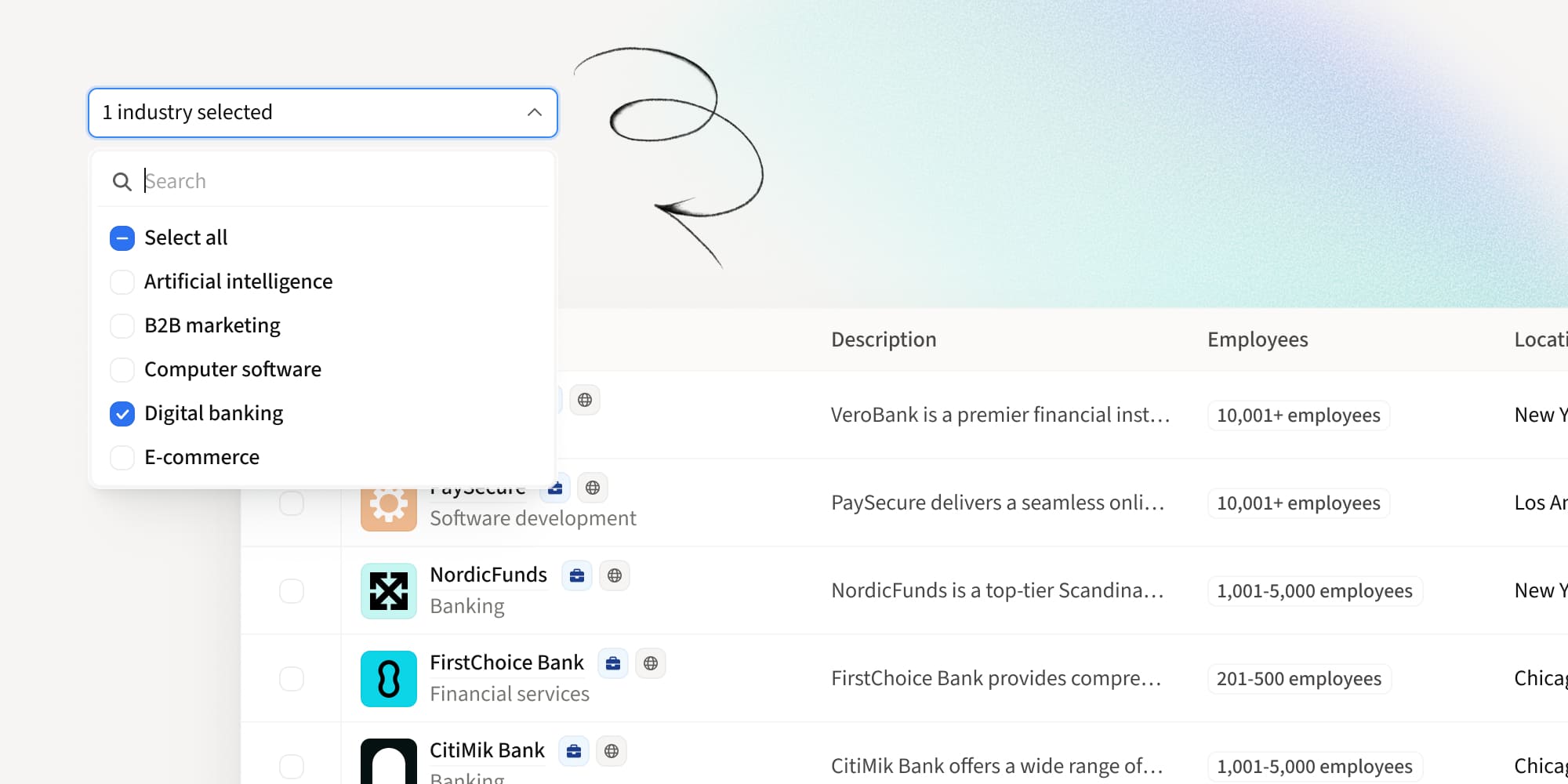6 Examples of Buying Intent Signals to power your pipeline
•
May 25, 2022

Understanding the intention of your target audience is just vital to help you:
- Find the right person
- Deliver the right message
- At the right time
Intent data guides you towards reaching out to your target audience when considering a solution for the problem you solve and helps you craft the right message to successfully tackle their pain-points.
Having a process to gather insightful buying intent data makes outbound teams very successful in their approach. Conversion rates double and sales reps have more insightful discussions with prospects about how they can help solve their problems.
The question is, where do you find this magic data?
No worries, get your notes because we'll give you a lot of inspiration below 😎
Here's what we'll cover:
- What is buying intent data
- 6 examples of buying intent signals in outbound sales (The basics)
- Developing case-specific strategies around buying intent signals (Advanced)
- Utilizing buying signals to close sales (Extra-advanced)
Understanding buying signals in sales
Buying intent data is behavioral data about potential customers. You can gauge how likely someone is to consider purchasing your product or service by collecting the right data points.
This allows you supercharge your sales funnel because you can skip the top-of-funnel lead generation and qualification stages and focus directly in mid-funnel, ready-to-buy prospects.
For example, suppose someone signs up for a demo with one of your closest competitors. In that case, they may also consider purchasing yours (if they knew about your product). Thus, collecting such behavioral data on your competitor's demo page would probably be one of the strongest buying intent signals.
Did you get that?
Great. Now let's dive into some practical examples of buying signals.👇
6 examples of buying intent signals in outbound sales (The basics)
1. Identify new managers on growing teams
When a new manager with high decision-making power (think a VP or C-level) joins a new team, they will be reviewing the entire team's strategy.
This means the company's leadership will have a new vision, and things will be shaken up internally. In a nutshell, managers will be looking for the right tools the team will need to succeed.
This is excellent timing to reach out because everyone is in an explorative mindset and eager to hear about any potential solution that could help them achieve their goals.
If you want to add an extra level of urgency, you can filter for recent managers on growing teams. This will ensure they are shaking things up internally, have the urgency, and have a budget to spend.
👉 How to find new managers on growing teams:
- Open LinkedIn Sales Navigator
- Issue a new search
- At the account level, filter for the desired department headcount growth
- Change to lead filters, select the tab 'Changed jobs in the past 90 days
2. Extract lists of competitor webinar attendees
Webinars are great proxies to understand which pain points a specific audience is feeling.
Suppose someone attends a webinar on building a social following on LinkedIn. In that case, it likely means this person is at least considering building an audience on LinkedIn. If you help with this, you have a great audience there.
Your established competitors know this exceptionally well. They have tried multiple content topics and understand what your audience is looking for.
The best part is finding exactly who is attending these events publicly on LinkedIn and using it to your advantage. Even before you've reached out, you already know this audience is qualified in terms of need, authority, and timing. How great is that?
👉 How to find attendees of a company event online:
With Amplemarket:
- Go to the Searcher
- In the events filter, choose an event you want to target
- Add any additional filters to narrow the list for your ICP
- Gather all the relevant contacts in a Customer Profile
Without Amplemarket:
- Go to your competitor's LinkedIn page
- Select the 'Events' tab
- Open a relevant event and click to attend
- View the attendees' list
- Open a Phantombuster account and run a LinkedIn search phantom to extract all the contacts in the list*
*Alternatively, use Amplemarket's LinkedIn Extension to extract the entire list to a Customer Profile with one click.
3. Leverage unhappy customer reviews
Websites like G2, Capterra, and FeaturedCustomers are great knowledge sources about your competitors. Not only can you use these reviews to learn more about issues that people face, but you can also identify potential new customers from unhappy reviews.
In these reviews, unhappy customers post what they dislike about your competitors. If you solve those problems better than your competitors do, then these people are potential happy customers of your product/service.
👉 How to find people posting negative reviews:
- Jump right into G2, Capterra, or FeaturedCustomers
- Browse for your competitor's reviews
- Filter for the worst classified reviews
- 90% of the time, you'll get their name, the title, and profile picture
- Find them on LinkedIn and see if the name, title, and picture match
4. Look for companies hiring and using a tool you integrate with
Companies that are hiring have a budget to spend and need new tools to accommodate the team's growth.
Imagine a growing company is already using a tool you integrate with. In that circumstance, it means they are already familiar with your market and will not have to migrate their current stack to make things work.
👉 How to find these companies?
With Amplemarket:
- Go to the Amplemarket Searcher
- Select a company hub for companies hiring right now
- Filter for companies using a tool you integrate with
Without Amplemarket:
- Find companies hiring on LinkedIn
- Use builtwith.com to find which tools they are using
- Filter the ones who are using the tool you integrate with on a spreadsheet
5. Engage with people who downloaded or interacted with a relevant online resource
Providing helpful and free resources to your niche is beneficial in many ways. On the one hand, you raise brand awareness with insights people trust. On the other hand, you get buying intent signals about which leads are feeling a specific problem right now.
👉 How to efficiently engage when someone downloads a relevant resource on your website?
With Amplemarket:
- Create a sequence template with a compelling message for this audience
- Make sure the marketing team sends the email to an Amplemarket Inbound Smart Action via webhooks whenever someone subscribes to the content (see how here)
- Turn the Smart Action on and let Amplemarket do the rest
Note: Make sure your sales team is aligned with marketing so that you'll have resources that showcase the highest buying intent possible.
6. Spot relevant questions in niche online communities
Participating in relevant niche communities like Slack and LinkedIn groups increases your social reputation and helps you find opportunities to help people when they are desperate to solve a problem.
With Zapier, you can set reminders in your favorite tools to let you know when someone is talking about something relevant to you.
This is a high effort strategy but pays off quickly when people start trusting you to help them in multiple situations. You come across as someone who's there to help them succeed rather than someone who's there to sell.
Developing case-specific strategies around buying signals (Advanced)
Some buying intent signals are specific to each company's use case. Only YOU can leverage those.
For example, think you're a company offering services to remote teams. In that case, you should be able to identify growing remote teams that could benefit from a solution like yours.
In this specific use case, you have to find companies that are openly hiring new employees remotely or companies that only have 1 office but have employees distributed across multiple locations.
This data is difficult to find but has massive potential for growth. Leverage your lead generation data provider for granular insights like this, and then use one hyper-personalized cold email templates to maximize reply rates around these prospect segments.
Alternatively, you might want to consider Amplemarket's unprecedented search criteria to understand your prospects like none of your competitors can.
Utilizing buying signals to close sales (extra-advanced)
Remember the first example about buying intent data in this article?
Yes, the one about who's taking demos and talking with your competitor's sales team.
What if we told you that you could get your hands on data like this?
We just launched Amplemarket Buying Intent Signals! With this, we can tell you the exact people evaluating one of your competitors (e.g.: the person taking a demo with your competitor, talking to their sales team, etc.).
We do that with an algorithm that leverages the digital footprint of your competitors' sales teams and tells you which leads have the highest buying intent right now.
Not fully convinced? See how we've helped Vanta close 6 figures within the first 3 months of using Amplemarket Buying Intent Signals.

Subscribe to Amplemarket Blog
Sales tips, email resources, marketing content, and more.










